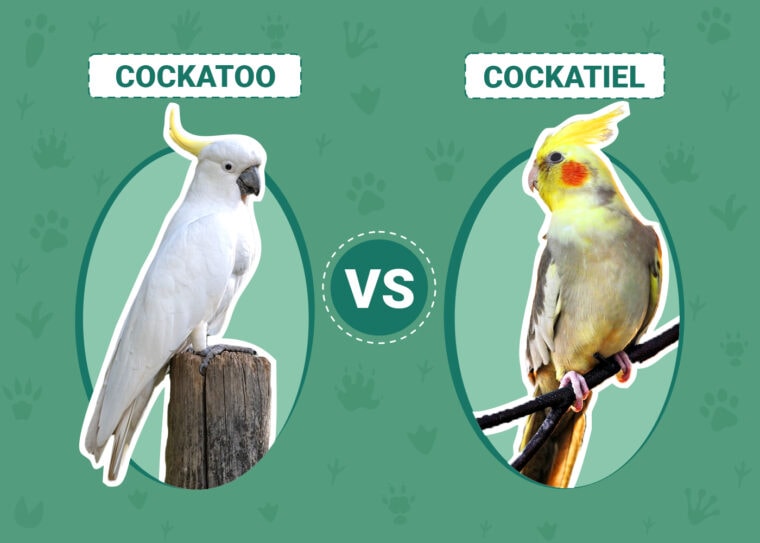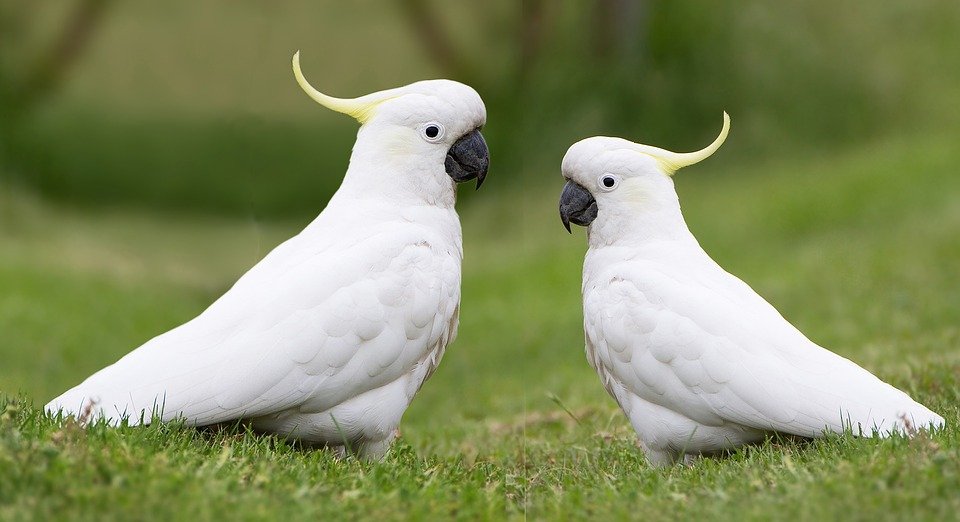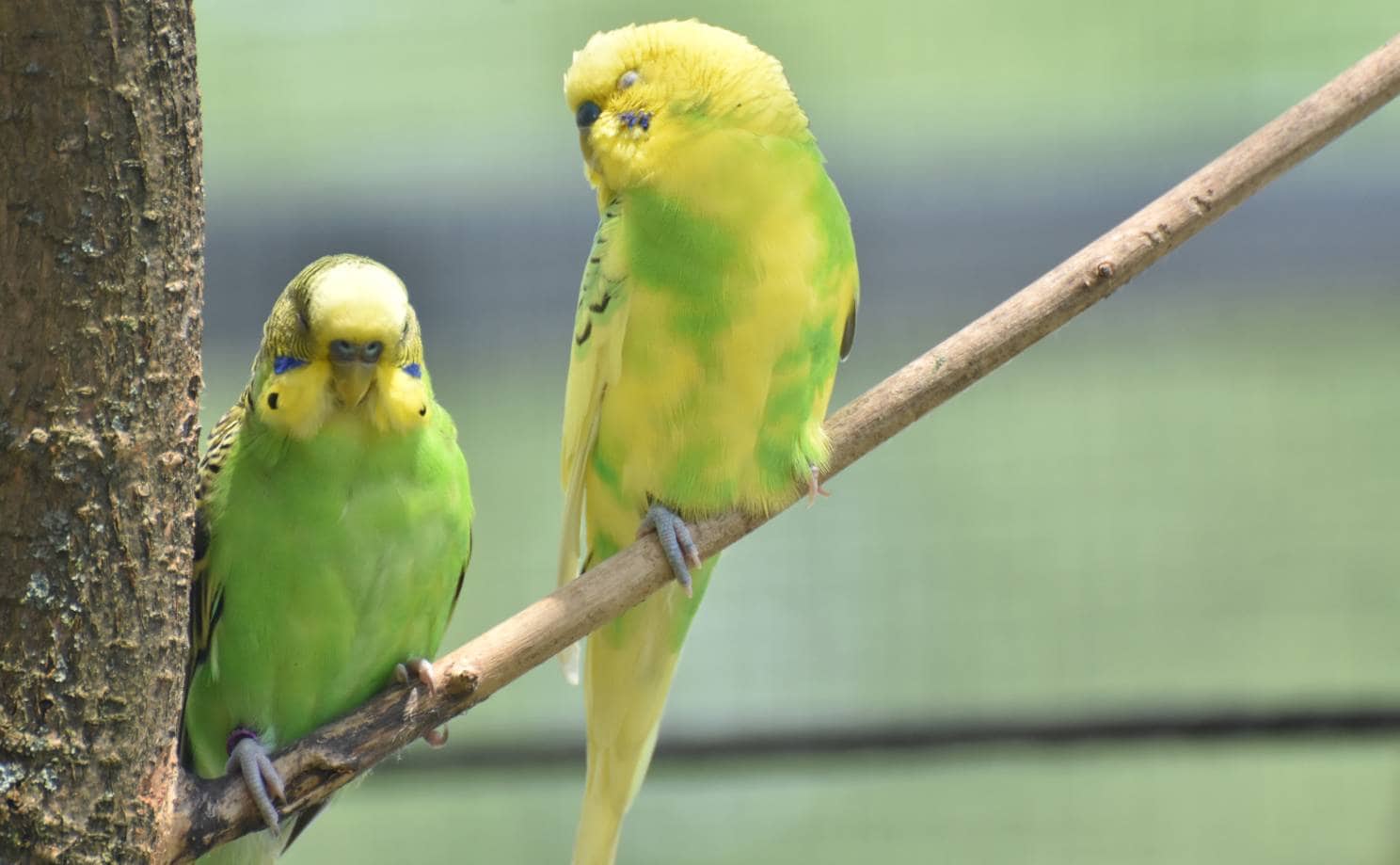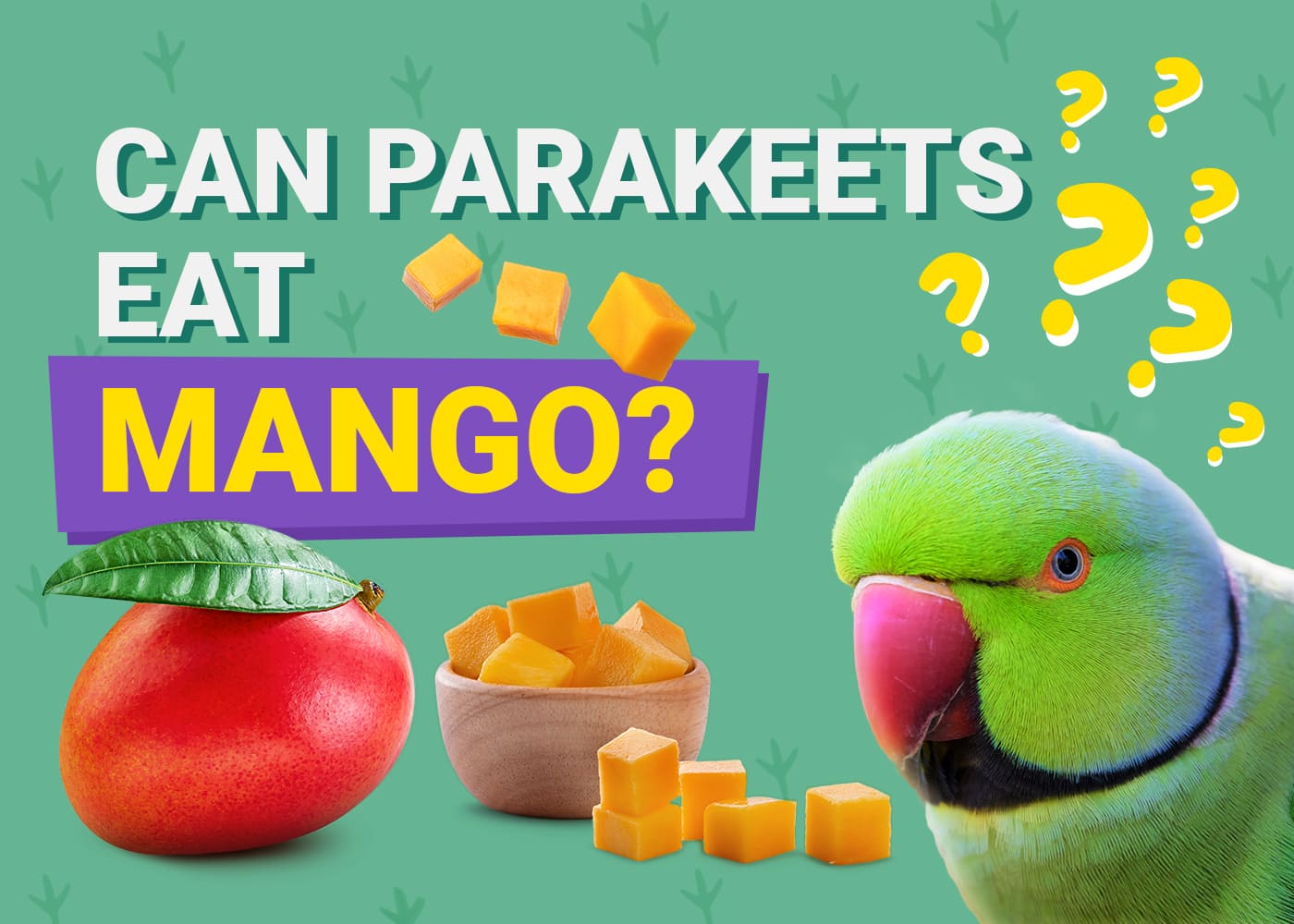
Click to Skip Ahead
Cockatiels are one of the most popular pet birds in the United States, second only to Parakeets (Budgies), and they are often mistaken for the similar Cockatoo. While the two are different when you know what to look for, they are actually a part of the same family of birds, the Cockatiel being the smallest member of the Cockatoo species.
There are 21 different species of Cockatoos within this family of birds, the Cacatuidae family, all of which are native to the Australian wetlands and bushlands. In this article, we’ll take an in-depth look at the Cockatiel and the Cockatoo to see exactly what makes them so uniquely different.
Visual Differences

The first and most obvious difference between these two birds is their size; Cockatiels are the smallest members of the Cockatoo family and are thus at least half the size of their close Cockatoo cousins. Color is another large differentiator. Cockatoos generally have fairly plain and solid coloring, whereas Cockatiels are brightly colored and come in a wide variety of different shades and color combinations. This is the result of a unique genetic mutation found in captive Cockatiels, one that has spawned several different colorations.
At a Glance
Cockatoo Overview

Cockatoos originate in Australia, the Indonesian Islands, and New Guinea, with habitats ranging from woodlands to coastal plains depending on the species. Contrary to popular belief, the Cockatoo is not one bird but a family of birds consisting of over 21 different species, including the smaller Cockatiel. They are instantly recognizable birds, with a beautiful fan of feathers crowning the tops of their heads, and most have incredibly long lifespans of up to 60 years or more in rare cases.
Personality / Character
Cockatoos are often referred to as “Velcro birds” because they form such strong bonds with their owners when raised under human care. They are also revered as one of the most affectionate of bird species, and these unique bonds with their owners will last a lifetime. Often, these birds may outlive their owners, and some have been known to become extremely depressed and even rumored to die of a broken heart without their owners.
Cockatoos are notoriously loud and vocal, and as such, they are not suited for small apartments or small homes with close neighbors. This is further bolstered by the fact that their favorite time to make a racket is early in the morning and at sunset, a natural trait in the wild, and the exact time that your neighbors will most likely be at home!
Training
If Cockatoos are hand-reared and socialized properly, they are highly affectionate birds that are easy to train. They can be trained to perform tricks and play games, and although they can certainly be taught to mimic speech, they have fairly limited vocabulary compared to many other parrot species. Cockatoos are notorious for their chewing and will quickly destroy poorly constructed toys or cages when given the opportunity. Socialization and adequate mental and physical stimulation from toys and regular interaction are essential to good training.

Health & Care
Most species of Cockatoo have exceedingly long lifespans — in rare cases, up to 100 years! — and are, as you’d expect from this fact, hardy animals when properly looked after. They are also extremely clean animals by nature and will almost continually preen themselves. While they are fairly easy to care for, these birds do require a ton of attention, and with their incredible lifespans, they are not an ideal choice for beginners.
Suitability
Cockatiels make wonderful, long-lived companions that form powerful, lasting bonds with their owners. With this long lifespan and intense bond comes a ton of responsibility, and bringing home a Cockatiel as a pet is a decision that should not be taken lightly. These birds need a great deal of attention and interaction, and as such, they are not a good choice for owners who are away from home frequently. However, if you have the time and dedication needed, they can make a wonderful companion that will form a lifelong bond with you.
- Related Read: Goffin’s Cockatoo
Cockatiel Overview
Cockatiels are one of the most popular pet birds in the United States and indeed, the world. This comes as no surprise, as they are beautiful, intelligent, and affectionate birds that have been domesticated for decades. Cockatiels are easy to breed and this has caused a close relationship with humans that makes for an exceedingly adaptable companion. It is illegal to take a Cockatiel from the wild.

Personality / Character
Another reason for the Cockatiel’s popularity as pets is their friendly and easy-going temperament. They are great for beginner bird enthusiasts and are highly social animals that are a breeze to look after. This social aspect is an important factor in their personality, and they need constant company from their family or another bird, as they can swiftly become depressed otherwise. While Cockatiels do not acquire the extensive vocabularies of many other parrot species, they can still be taught to mimic a few dozen words with the right training. Even so, they are certainly not quiet birds and make a host of unique whistles, singing, and even screaming!
Training
Since Cockatiels are so social and love being close to their owners, training is usually no issue. With early socialization, they are a breeze to train and can easily be taught to perform tricks, play games, and mimic a limited vocabulary. The Cockatiel’s crest will tell you all you need to know about their mood, and upright crest feathers are usually a sign of fear, whereas feathers held slightly back and a bobbing head are usually good indicators that they are in a great mood and ready for training!

Health & Care
Cockatiels may not have the incredibly long lifespans of their Cockatoo cousins, but they are certainly not short-lived creatures. They can often live for up to 20 years under human care and are known as healthy and hardy birds. All they need is occasional nail trimming and wing clipping and will enjoy an occasional bath in their cage. That said, bathing them is not necessary as they are, like most birds in the Cockatoo family, naturally clean birds that preen themselves constantly.
Suitability
Cockatiels are extremely friendly, social, and easy-going birds that are easy to care for, making them an ideal species for beginners looking to care for a pet bird. They do not have the same exceptionally long lifespans of their Cockatoo cousins and do not carry the weight of a lifelong responsibility. That said, they can still live for longer than most dogs or cats, and this is not a responsibility that should be taken lightly. Their small size is also a plus because they are easy to handle and move around and are great to have around children.
If you’re new to the wonderful world of cockatiels, you’ll need a great resource to help your birds thrive. We highly recommend taking a closer look at The Ultimate Guide to Cockatiels, available on Amazon.
This excellent book covers everything from the history, color mutations, and anatomy of cockatiels to expert housing, feeding, breeding, and health care tips.
Cockatiel Colors

In general, Cockatoos are not brightly colored, especially in the wild, and the same can be said of wild Cockatiels. However, captive-bred Cockatiels come in several unique color variations. The unique coloring of some Cockatiels comes from a sex-linked recessive genetic mutation. This mutation lacks the gray coloring found in most Cockatiels and is replaced by unique color combinations not found in the wild, including:
Final Thoughts
While Cockatoos and Cockatiels are members of the same family, there are important differences between the two.
The main physical differences are easy to spot: Cockatiels are far smaller than Cockatoos, often at least half the size, they come in a wide variety of colors due to their domestication, and they have much smaller beaks in comparison to their size. Cockatoos have exceptionally long lifespans, sometimes up to 100 years, whereas Cockatiels will only live up to a maximum of about 20. Cockatiels are generally calmer and more docile than Cockatoos, making them easier to look after and care for. Lastly, Cockatoos require more space and time outside their cage than Cockatiels and are generally more expensive to purchase.
Both these birds make great pets, and due to their affectionate and social nature and the strong bonds that they form with their owners, both require a ton of attention and interaction. No matter which bird you decide to bring home, they are a massive responsibility, and owning one of these beautiful birds is not a decision to be taken lightly.
Featured Image Credit: Top – ignartonosbg, Pixabay | Bottom – Jiří Mikoláš, Pexels









